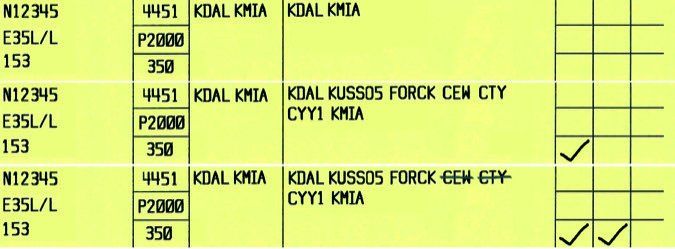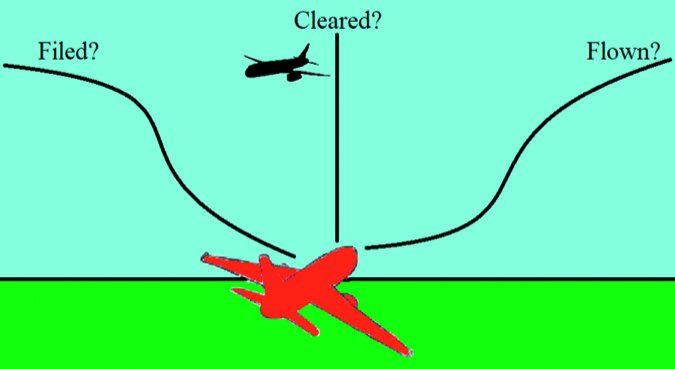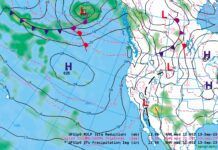Every instrument pilot should understand the process of filing, getting a clearance, and then flying an IFR flight plan. But why does it occasionally seem that ATC makes things complicated? Say you’ve filed a straightforward Point A to B then C. But then you’re cleared from Point A to B then to X, Y, Z, and only finally to Point C. Why are these extra fixes in the flight plan? Where did they come from? Why this today instead of an intermediate RNAV fix that you usually get?
I actually get this question more than any other. These seemingly indirect routings might look like a lot more work than something simple, but they keep all airplanes moving safely. Sometimes there may not be much the pilot can do differently, but there are a few ways to possibly anticipate and plan the best route without having to redo it 10 times. The overriding key to this, of course, is that everything aviation is constantly changing, including the optimum route needed of you to keep the entire system moving smoothly.
What You File
Let’s start with a little test:
Are you’re using the ICAO flight plan format now? Please select your answer.
a) Yes
b) Yes
After years of stalling, the FAA has finally obsoleted its familiar flight plan form and joined the rest of the world, now only accepting the oft-confusing ICAO format. Now, with that bit of housekeeping out of the way…
Do you normally file direct to destination and hope for the best or do you file a very specific route for which you’ve painstakingly calculated your exact time and fuel requirements? In certain areas, you can indeed get direct but it’s risky to count on that. Some pilots/dispatchers file from airport to airport direct, while others try to file a carefully crafted route with a specified Departure Procedure (DP), one or more intermediate intersections or waypoints, and even airways or at least airway segments, then a Standard Terminal Arrival Route (STAR) to the destination.
As I tell every pilot who is trying to find the best and fastest route, it all depends on what the system gives you on a particular day. On the pilot’s side, it depends on altitude, type airplane, equipment, proposed departure time, etc. Now on the national airspace system (NAS) side, there could be TFRs, active MOAs, restricted areas, bad weather that calls for ATC severe weather avoidance procedures (SWAPs), or a LOA (letter of agreement) that could take you on a longer route, etc. These all can change often and quickly, especially in congested areas or Class Bravo airspace.
I covered SWAPs at some length in Going Around Weather in August 2019, but to keep it simple: An area might have 16 departure gates, eight of which would normally be available to your routing, four of those are blocked by weather, and two are near a busy airport. It doesn’t allow you many options, and I assure you, it is not ATC forcing your hand.
I work at a Class D Tower, so most of the time, I don’t know or care what’s happening 1000 miles away, but the ARTCC Traffic Management Unit (TMU) usually does know and they (using a few other resources) decide if restricted routing is required. Don’t forget, another major reason you could get a drawn out clearance is for NORDO (No Radio) procedures. It’s very rare in today’s aviation world that an airplane that is IFR goes NORDO with ATC and continues all the way to the destination, especially if the destination is within a Class B or very busy Class C. But, if you are in IMC, ATC understands and will follow you to the ground, wherever that may be.
How ATC Clears You
After you file your IFR flight plan and before taxi, you call to pick up your clearance. N12345, cleared to the XYZ airport via radar vectors to the NORTH1 departure, WEST transition, ZYX VOR, direct. On departure fly runway heading. Climb via the SID except maintain 2000. Expect 9000 ten minutes after. Departure frequency 123.45. Squawk 4567. You read it back perfectly, but are wondering why this route takes you 25 miles out of the way from the filed route. You are somewhat unfamiliar with this area of airspace and procedures, so you query the controller and you’re told, All departures that direction at that altitude get the NORTH1 and runway heading, maintain 2000.
You acknowledge, but are still somewhat confused thinking, Why would they have a departure procedure but amend all departures to climb via the SID and maintain a lower altitude than published? It could be any number of reasons. One of the most common I’ve seen in this scenario, is a letter of agreement with another facility saying that certain aircraft types will fly the DP at a different, designated altitude due to the airspace, flow, new routing, etc.
It’s also possible that a new DP has been designed, and until it becomes permanent, letters of agreement are altered to change the existing DP. Make sure you keep your charts/chart supplements up to date. A while ago, my airport was undergoing major reconstruction, so I constantly had pilots asking where the taxiways (that had been demolished) are, and I had to explain to them that the airport diagram had not been updated and give progressive taxi instructions. Other than asking local pilots and ATC, there was no way an unfamiliar pilot would have known.
Other things one might think about when receiving an unusual routing are temporary obstructions such as air shows or presidential TFRs, or in certain parts of the U.S., wildfires. Most TFRs or flight restrictions are known well in advance. However, there could always be that one time the pilot didn’t check the NOTAMs, controllers aren’t properly briefed and might not know until the TFR is active, and confusion leads to close calls. As the NAS continues to grow and to be as safe as possible, around 45,000 flights and 2.7 million passengers could be shifted ever so slightly to make room for that additional flight, and it might happen at a moment’s notice. That said, we do try to give IFR aircraft direct routing as often as we can.
What You Fly

After you double check your gas and make sure you can fly the route issued, you start up, taxi out, and depart. Once you’re up and radar identified, ATC tells you to proceed direct to the ZYX transition, climb and maintain 6000 instead of flying to the first waypoint in the DP. You comply. Halfway to that waypoint, ATC tells you, Climb and maintain 9000 feet, proceed direct destination. Since this instruction brightens your day, you comply without question and hope the controller had his coffee and doesn’t change his mind.
One part of you is thinking, What the heck? The other part is thinking, Oh Yeah! I’ll take direct any day! The third part is, What’s with all the hassle only to go direct? One of the biggest reasons you might experience this is due to volume within an approach controller’s airspace or fewer restrictions at your destination. With enough planes in the air, no one gets shortcuts. You can always ask for a shortcut if you like, but don’t hold your breath, especially if the controller is busy. To keep things at the safest they can be, everyone has a line to follow, which keeps the safety high but can sacrifice efficiency.
There are some known pushes where controllers working busy airspace know it will become even busier than average. This is when you get your route and will follow it until you exit the area. Maybe the push was late due to weather in other parts of the country, or weather on the normal arrival path. Any number of reasons could be to blame. One of the best pieces of advice I could give you is to carry more than the 91.167-mandated amount of fuel so you’ve got enough to accommodate unplanned reroutes like this.
Why?
In the end, unless you have a valid reason to ignore an ATC instruction, you follow them. But at the same time, you are thinking, What a waste of time to go through all that only to have it changed, then changed again, then back to what I started with! It’s all about point of view. From the NAS perspective, the challenge is to get everyone to their destination as safely and efficiently as possible. To meet that lofty goal, not everyone gets exactly what they want, but in the end, total system efficiency and safety are maximized.
To the pilotand sometimes even controllersthese broader considerations can seem to get in the way. But our system has been operating with amazing safety and capability for a very long time, so we must realize that there is a reason behind every vector, every altitude change, and every controller decision.
There is always something that you or even the controller cannot see. In the bigger picture grand scheme of things, the controller gives you a clearance because of something neither of you might even understand, but there are reasons so the controller clears you and you fly it. Fly safe!
Try Again…and Again…and Again
A short time ago, I was working Ground and Clearance Delivery combined. It was a beautiful day with all departure gates open and no restrictions. I had a few clearances that hadn’t yet been picked up, and one or two planes taxing out, when I got a call from Mr. Citation X. Ground, N12345, clearance to XYZ airport. I found his clearance and was able to see what he filed compared to what the system gave him. N12345, cleared to the XYZ airport via radar vectors to the SOUTH1 departure TATWY transition, ABC VOR to CBA VOR, then the LOWER1 arrival. Fly runway heading. Maintain 4000; expect flight level 180, one zero minutes after. Departure is 123.45, squawk 2345.
Normally pilots come right back and start reading it out like they have somewhere to be, but in this case, I actually waited a minute and had two more planes taxi out. He finally responded, Uhhh, clearance we filed a more direct route, why did we get all that? I responded, Sir, that’s what the NAS gives us. That is your clearance, advise ready to read back … A few seconds goes by, Yeah we are going to re-file, we don’t want to go out of our way. I quickly replied, Sir, regardless of what you’re planning to file, that is the route that most pilots have been getting today, toward that same destination. Weather you add more or fewer waypoints, it will probably remain close to what I gave you. Yeah, okay. Well we’re going to refile anyways, thanks…
I told my co-worker standing next to me about it and we both just shook our heads. Five minutes later, another flight plan for the same airplane popped out of the flight strip printer. To no surprise, there was a different filed route, but the route the system gave me was the same exact route I had just read to the pilot. He called shortly after, Clearance, N12345, we refiled. Can you let us know when it shows? I replied, Yes Sir, it just came out of the printer, and despite the filed change, your route remains the same. There was silence for another minute. Then, Okay, I’ll file again.
I kept on working, knowing his efforts were in vain. But if he wants to keep filing, then I’ll just keep giving him the same clearance. A third flight plan pops out. Yup, you guessed itsame routing. He actually filed direct, and got the same route as he did the first time. Finally, Clearance, N12345, we refiled. N12345, Clearance, yes sir I see it, and it’s the same clearance I already gave you. Advise ready to readback. Obviously agitated, the pilot comes back and reads it verbatim. Readback correct. Of course, the devil in me had to add, Have a nice flight.
The plane finally took off and apparently didn’t even have to go toward the VORs; he got direct after the DP transition. Ours is a very specific area with very specific routes that must be issued while the airplane is on the ground because of the real potential for heavy traffic. But once they are in the air if there isn’t a lot of traffic in the way, most aircraft get close to what they want. I hope he reads this to understand what happened. EH






As a Active CFI this seems an overly long article about routing that could be simplified.
The route you plan and “file” vs, what you are “cleared”, and vs. your “actual” route flown may often be different.
You can file direct or you can use a tool like Foreflight to file a route that has been previously approved. Nevertheless, the route you receive or are “cleared” may be different due to TFR’s, weather, traffic volume, etc. The moral of the story is don’t over work your route planning or get emotionally attached to a route you filed.
Once you are airborne and check in with ATC you may receive different routing. If traffic and ATC workload is light you might be assigned a more direct route. On the other hand if traffic is heavy for example when entering class C or Class B airspace, you may be assigned an arrival procedure or other special routing.
In summary when flying IFR you should be prepared to accept changes in your planned routing.
Lol and your long comment repeated what the author wrote in his article. We’re you that pilot that kept refilling? 😉
So you were the pilot that kept refiling?
Dude, just just repeated back with the author wrote. Unbelievable
Good explanation. I’ll include it when I explain unexpected changes to my Instrument students. Thanks!
Superb review, which is the singular reason to read IFR regularly. I too actively instruct in high performance aircraft, however, I find the minutia and finite detail of this subject reason to review my flight planning presentations to include the authors emphasis items.
I am curious — how useful are the IFR “Route Advisor” functions that we see in Foreflight (and others)?
I am an active CFII with many students. I have each one go through the planning, filing, copying the clearance for every flight. It is often frustrating for them when they don’t “get what they expected”, but a valuable lesson. One thing I don’t understand is why the technology is not better utilized by ATC. All EFB’s (at least the ones with which I am familiar) use preferred routes and/or the latest provided by ATC based on altitude, type of aircraft/ equipment, etc. When a filing is forwarded, you would think that the ATC routing could be pushed back to the pilot so they can at least be ready for the clearance.
Prefered Routes, use them, or parts of them, and get fewer surprises. Published in the Chart Supplement, and usually the source of the routing provided in the EFBs.
How many times have you heard someone whining about being vectored around an active MOA? Here’s an idea, see when they are active, plan around them, request direct, if granted, be happy.
…and more than likely, request granted.
Be happy is on the button.
Tune in to the voice of the controller, reply like a peashooter, and you’ll be cleared through an active MOA without a pause and probably a spectacular observation of green 4 and 8 engine students doing pattern work.
First thing my CFII’s did for Instrument training out of KTEB (NY Delta under Bravo) was hand me an FBO printout of ATC preferred routes.
No matter what you want, it’s what New York traffic control wants.
Follow the rules, and all you have to do is keep tapping the fuel gauge and keep an eye on the airplane clock.